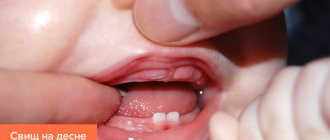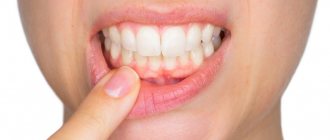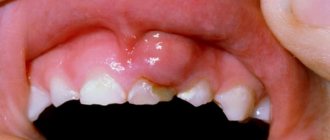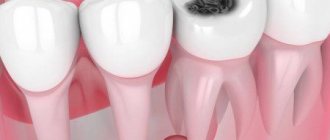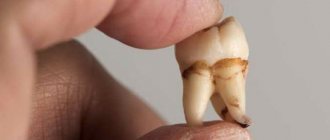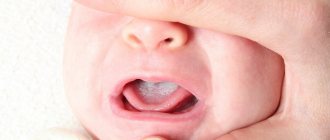Swelling of the gums always indicates the presence of an infection in one of the teeth: swelling in most cases appears near the affected tooth.
Sometimes the tooth that caused the swelling has a carious formation and has a crown or filling. It happens that before a swelling forms, the tooth hurts, although in some cases there may be no pain at all. The causative tooth may lose its stability (become mobile), and when biting there is a high probability of pain.
Why is the enamel grinding procedure carried out?
Grinding of teeth involves removing a layer of hard tissue (enamel and dentin), so that the orthopedic structure subsequently installed on the “support” looks natural and beautiful, fits tightly, is securely fixed, has stability and strength. This is also done to ensure that microbes do not get under the prosthesis or food debris gets clogged, which together can provoke the development of an inflammatory process.
On a note! Typically, the doctor removes a layer equal to the thickness of the chosen prosthesis. If a crown or bridge is installed, the tooth is ground down to a cone shape. When turning for microprostheses, for example, for veneers, the specialist “cuts down” the enamel in the frontal, lateral and cervical areas.
Often after the procedure, the patient’s gums around the ground tooth hurt, or the prepared element itself ache. Naturally, discomfort does not arise immediately, but after the anesthesia wears off. For some people, discomfort does not appear until several days, weeks or even months later. What is this connected with? We'll figure it out together.
Signs and symptoms of hyperplasia
Those who have this problem rarely experience pain right away. But almost all patients notice a visual violation of the aesthetics of a smile, because the gums become voluminous and loose, which, as a rule, is the reason for visiting a doctor.
Discomfort and pain appear after the tissues have grown significantly, and they involuntarily have to be constantly injured during hygiene procedures and eating food. Another sign is the appearance of bad breath, which does not go away after careful hygiene or quickly returns again.
Causes of painful sensations in teeth
1. Physiological response to intervention
This is the most common reason why teeth and gums hurt after grinding for crowns and other orthopedic structures. After all, during the procedure, the specialist acts on the tissue instrumentally and medicinally, touching the nerve endings. This reaction is considered normal.
On a note! If, after grinding teeth, hyperesthesia (increased sensitivity) and aching pain appear, especially during the consumption of cold, hot, sour and spicy foods, and hygienic cleaning, then this often simply indicates a thinning of the tissue area of the prepared unit.
Most often, hyperesthesia after turning occurs on vital, that is, living units where the pulp is preserved. Sensitivity is enhanced even despite the presence of temporary crowns, which, it would seem, serve as reliable protection from external irritants. Temporary structures are fixed immediately after preparation and worn until permanent dentures are created.
Medical errors
If a tooth or gum hurts after grinding, then unqualified actions by the doctor cannot be ruled out. Most often, inexperienced specialists make the following mistakes:
- overheating of the pulp: occurs when preparing tissue with a bur,
- removing too much tissue,
- nerve injury: to avoid complications associated with damage, overheating or inflammation of the nerve under the prosthesis, experienced specialists advise depulping the tooth, that is, first removing the pulp from it.
If the doctor made the mistakes listed above, then the pain makes itself felt almost immediately after the procedure and can persist for several weeks or even months.
3. Development of a pathological inflammatory process
If a lot of time has passed after medical manipulations, and you have severe discomfort and your teeth hurt after grinding for crowns and bridges, then this signals the development of various dental diseases: caries, pulpitis, periodontitis, cyst, granuloma, fistula, abscess, gumboil. In this case, the pain does not go away for a long time, intensifies with each subsequent day, and is poorly relieved by analgesics. Along the way, other alarming symptoms arise: purulent bumps appear on the gums, the gums and cheek swell, the body temperature rises, it becomes painful to chew and press on the causative element.
More often, the problem arises again due to the fault of a clinic specialist who, during the preparation and preparation of tissues before prosthetics, violated the rules of asepsis, did not fully treat (after all, dentures are often placed on teeth destroyed by deep caries and other dental diseases), poorly cleaned and poorly sealed the roots channels. Pulpitis can occur if, in the process of preparing the “support,” the doctor caused irreversible damage to the nerve.
Expert opinion
Andrey Rastislavovich Chernov
Specializations: Orthopedic dentist, gnathologist
Experience: 10+
“Treatment, grinding and prosthetics of a tooth with an orthopedic design is a complex and multi-stage process, in which at least several experienced specialists must take part - a therapist, a dental technician (creates a prosthesis using casts of the jaws), an orthopedic doctor. If everyone has done their job efficiently, then pain after completing all the manipulations should not arise either in the short or long term.”
Sometimes a pathological inflammatory process occurs due to the fault of a patient who systematically violates oral hygiene, does not monitor the condition of installed dentures and surrounding tissues, and receives various injuries.
Why does my gum hurt?
Sometimes the teeth do not react at all, but the gums hurt after grinding. Let's list the reasons for this:
- physiological reaction to an anesthetic injection,
- gum retraction: in order to qualitatively fit the prosthesis to the soft tissues and eliminate discomfort during operation, as well as to create a highly accurate design that fully corresponds to all the anatomical features of the patient, before taking impressions, specialists widen the periodontal sulcus. For the procedure, special threads are most often used, which are inserted under the gum and lift it. Such manipulations lead to the fact that the gums then become slightly inflamed and swollen, and also hurt for several days,
- individual reaction of the patient and allergies to the medications used during the grinding process: in this case, the gums may itch and itch, a rash appears on them,
- traumatic gingivitis and periodontitis: if in the process the specialist damaged the gums, then the patient experiences persistent aching pain, swelling and bleeding of the mucous membrane. As a rule, it all starts with gingivitis, but if the disease is neglected, it is complicated by periodontitis.
Methods of tissue trimming: after which procedures pain occurs more often
There are different ways to prepare tissue. According to experts, after grinding the teeth, some of them may actually experience aching pain. But other methods, on the contrary, are considered gentle, and therefore do not cause discomfort at any stage of treatment and prosthetics.
Using a diamond-tipped bur
The drill, despite the loud, annoying sound, is still popular among dentists, because with its help you can quickly and efficiently carry out work of any level of complexity and scale, and grind off any amount of tissue.
It is boron that is most often used for preparing tissue for crowns and bridges, and for turning teeth for veneers. During the process, the doctor uses the device at different speeds so that it does not cause overheating of the tissues and pulp; at the same time, a cooling liquid is supplied to the oral cavity. Despite all the safety measures, many patients note that it was after using boron that they experienced pain.
Via ultrasound
Situations where a tooth hurts after grinding performed using ultrasound are quite rare. The method is characterized by a more gentle effect, compared to boron[1], allows you to process fabrics carefully and without contact, and does not cause overheating. However, ultrasound can still cause discomfort and short-term increased sensitivity of hard tissues and gums in people with a low pain threshold and weakened enamel.
The method is used if you need to remove a small amount of tissue.
Laser method
Here, a laser is used for preparation, which, like ultrasound, acts in a targeted and non-contact manner. The method is considered one of the safest and most painless[2], suitable for people with sensitive gums and mucous membranes, and does not cause pain or discomfort. The laser not only carefully grinds the tissues, but also disinfects them, promotes rapid healing, and prevents bleeding.
Water-abrasive treatment
Suitable only in cases where a minimum amount of tissue needs to be removed. During the process, a specialist treats the enamel with a stream of water containing abrasive particles. After such grinding of teeth, aching pain and any discomfort are completely excluded.
On a note! Until recently, dentistry also used a chemical method, where tissues were first softened using chemicals and then removed with an instrument. However, today this method is recognized as traumatic and very dangerous for the nerve of the tooth.
How to relieve pain before visiting the dentist
If the tooth begins to ache, and a pulsation appears in the gums, you need to urgently run to the doctor. But toothache can strike at the most inopportune moment, so you need to know how to quickly relieve the symptom, at least until you visit a specialist. Below are detailed recommendations in this regard.
Pharmacy painkillers
Painkillers should be selected based on the characteristics of the pain syndrome, in particular its severity. For moderate pain, drugs from the category of non-steroidal anti-inflammatory drugs are recommended, including Aspirin and Paracetamol - one tablet will help alleviate the condition for just a couple of hours. If the discomfort intensifies in the evening, you can additionally take an antispasmodic, for example, “No-shpu” or “Spazmaton”. And remember: before taking any medications, it is better to consult your doctor in advance, at least by phone.
Pharmacy painkillers will help relieve pain
If the pain is too severe, and there is also pronounced pulsation in the gums, ordinary painkillers cannot be used. You will have to resort to stronger drugs, which include Ketorolac, Nise and Nimesulide. Here you need to clearly understand that painkillers only mask the problem, but do not solve it. If you feel much better after taking the pill, this does not mean that the pain will not return. The only solution to the problem is treatment under the close supervision of a dentist.
Traditional medicine tips
You can relieve swelling and muffle inflammation using traditional medicine. However, here it is also important to approach everything wisely - it is better to consult your doctor once again before using “grandmother’s” recipes. Here are some proven recommendations:
- rinsing with soda-salt solution: dissolve 2 g of soda and salt in a glass of warm water. Rinse your mouth after eating and every 15 minutes if the pain is too severe,
- propolis: chewing a small piece of propolis leads to slight numbness of the soft tissues, thereby reducing pain,
- decoctions of medicinal herbs: a teaspoon of dried and crushed plant is poured with 200 ml of boiling water and left for several hours. After this, filter and use for rinsing the mouth. The recipe is suitable for plants such as chamomile, sage and oak bark,
Chamomile infusion is great for rinsing - cold compress: to relieve pain and swelling, you can apply a cold compress to your cheek,
- essential oils: a piece of cotton wool soaked in eucalyptus or clove oil is applied to the causative tooth.
After acute manifestations of inflammatory processes have been eliminated, it is necessary to see a doctor as quickly as possible. If you put off going to a specialist for too long, saving yourself only with pharmaceutical painkillers, you can easily bring the situation to a critical limit, and then the question of possible tooth loss will arise.
- Grechishnikov V.V. Complex treatment of chronic destructive periodontitis of human teeth, 2001.
How long does the discomfort last?
Many patients are interested in how long their teeth can hurt after grinding. Normally, the unpleasant sensations disappear after 3-7 days. This is the case if the preparation was carried out without removing the nerve, or immediately after depulpation.
According to many experts, long-depulped teeth that have been ground should not hurt at all. If discomfort occurs, it goes away after 1-2 days.
When tissues and nerves are overheated with boron, increased sensitivity can persist for several months. But in any case, pain that intensifies and does not go away for more than one week should be a reason for a visit to the dentist.
Additional treatments
Considering that gums become inflamed for various reasons, it is important to try to find out the provoking factor. Then the risk of relapse of dental pathology can be reduced to a minimum.
If the doctor determines that the disorder is related to hormonal levels, it is necessary to select hormonal therapy . In case of malocclusion, consultation with an orthodontist is indicated. If the diet is unbalanced, the patient is told what the diet should be like after recovery.
Often, when fighting gum that has receded from a tooth, anti-inflammatory drugs, immunomodulators, glucocorticosteroids, and antiseptics are used. It is very important that the patient strictly follows all medical prescriptions and does not engage in amateur activities. An integrated and responsible approach to treating recession is a guarantee of a speedy recovery.
If the tissues become so inflamed that the teeth begin to loosen, splinting may be required. If there is a deficiency of bone tissue, their deficiency is compensated with special compounds.
What measures to take at home
When your teeth and gums hurt after grinding, it is important to know what to do in this situation. Usually, to quickly eliminate the physiological reaction of tissues to intervention, doctors advise performing the following procedures:
- mouth rinse: you can use chlorhexidine solution, Rokotan. Decoctions of chamomile and sage, which have a calming, antiseptic and anti-inflammatory effect, are also suitable. Rinsing is carried out 2-3 times a day,
- applications: if the gums hurt, it is recommended to apply Solcoseryl ointment to it up to 3-5 times a day,
- taking painkillers from a home medicine cabinet,
- following a gentle diet: in order not to further irritate sensitive tissues, it is necessary to exclude solid, cold and hot foods from the diet. It is better to also give up sour, salty, spicy and sweet foods for a while,
- Carrying out oral hygiene as carefully as possible: if your gums and sharpened teeth hurt, then under no circumstances should you stop performing hygiene procedures. However, to minimize discomfort, you can temporarily switch to a brush with soft bristles and a paste with anti-inflammatory components (chamomile, propolis).


